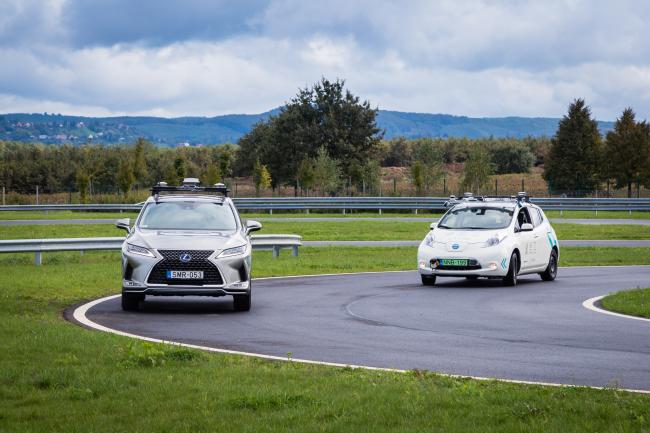The National Laboratory for Autonomous Systems coordinated by SZTAKI presented its demonstrations at ZalaZone
In the frame of the 4th ZalaZONE Innovation Day that was held on 30 September 2022 (4ZZID), ARNL researchers and developers held several live vehicle demonstrations for interested visitors and for the representatives of the Ministry of Technology and Industry (TIM) at the ZalaZONE automotive test track.
Automated Valet Parking
In the framework of 4ZZID, an automated valet parking function developed in cooperation between SZTAKI and BME researchers was presented. The essence of this intelligent vehicular feature is that a driver can call his/her vehicle to the exit of the parking lot using a mobile app. In order to be able to execute this complex task, the vehicle needs to possess various driver competences, furthermore, the algorithms implementing these competences need to be properly integrated.
This task requires the cooperation of several subsystems of the autonomous vehicle's environment sensing and intelligent control system. The vehicle with valet-parking function must be able to autonomously plan and follow routes, locate objects within the parking area, and detect both static obstacles and moving people/vehicles in the parking area. During the manoeuvre, the vehicle must be able to make decisions on its own. The vehicle control system communicates with the mobile app via computer cloud.
Drone tracking with a particle filter algorithm using rosette-scanning LIDAR data
Detection, identification and tracking of flying objects has long been an important research area in computer vision. For many ways now, LIDARs are more suitable for tracking flying objects than conventional cameras, but due to their size and price, they have so far been used mainly in laboratory and military systems. Thanks to technological advances in the field, there are now more compact LIDARs available for such applications. Such LIDARs may not be as powerful as their larger and more expensive competitors, but they can still be used for tracking drones.
The Livox LIDAR sensor that scans its field of view using a number of laser beams arranged in a line. The movement of laser beams follows an optimized, non-repetitive rosette-like pattern. For its users, such as automotive manufacturers, this solution results in a faster measurement, can be realized through a cheaper construction and smaller sensor dimension.
In recent years, researchers at SZTAKI have developed a new technology that uses such LIDARs to identify and track drone movements within a distance. In the demonstration held at the 4ZZID, a larger six-rotor drone was tracked by the LIDAR-based device, with the drone flying at its farthest point about 100 metres.
The live demonstration of the Forerunner drone’s capabilities
The SZTAKI researchers presented their Forerunner drone, which has been developed in a joint project with the Széchenyi University in Győr, and its technical capabilities six times during the 4ZZID to the changing audience. The live demonstration was held in the ZalaZONE’s Smart City.
The R&D carried out in the aforementioned project has been motivated by a series of serious accidents within the country, and especially by those that involved first response units and where the drivers’ better awareness of the local traffic situation could have prevented the accident. A tragic accident that involved an ambulance car and its crew occurred in Csepel (Budapest, Hungary) earlier this year. The accident was widely reported and discussed in the Hungarian press.
The aim of this unique forerunner drone development project is to develop a drone equipped with a camera that accompanies a deployed first response unit (e.g., ambulance, fire brigade, police cars) in the air, flies preferably ahead of it and safeguards the unit and its crew from above. In this way, areas hidden from the driver’s view can be surveilled in advance and the driver of the first response unit can be warned of the dangers looming in the area so that the accidents can be avoided.
The R&D is being carried out at the Széchenyi István University in Győr in cooperation with the ELKH SZTAKI and the National Laboratory of Autonomous Systems. A video about the forerunner drone and its capabilities was recorded at the “Safety Week” event-series (19-24 September 2022) organized by the Association of Hungarian Insurance Companies. It can be seen at the link below:
